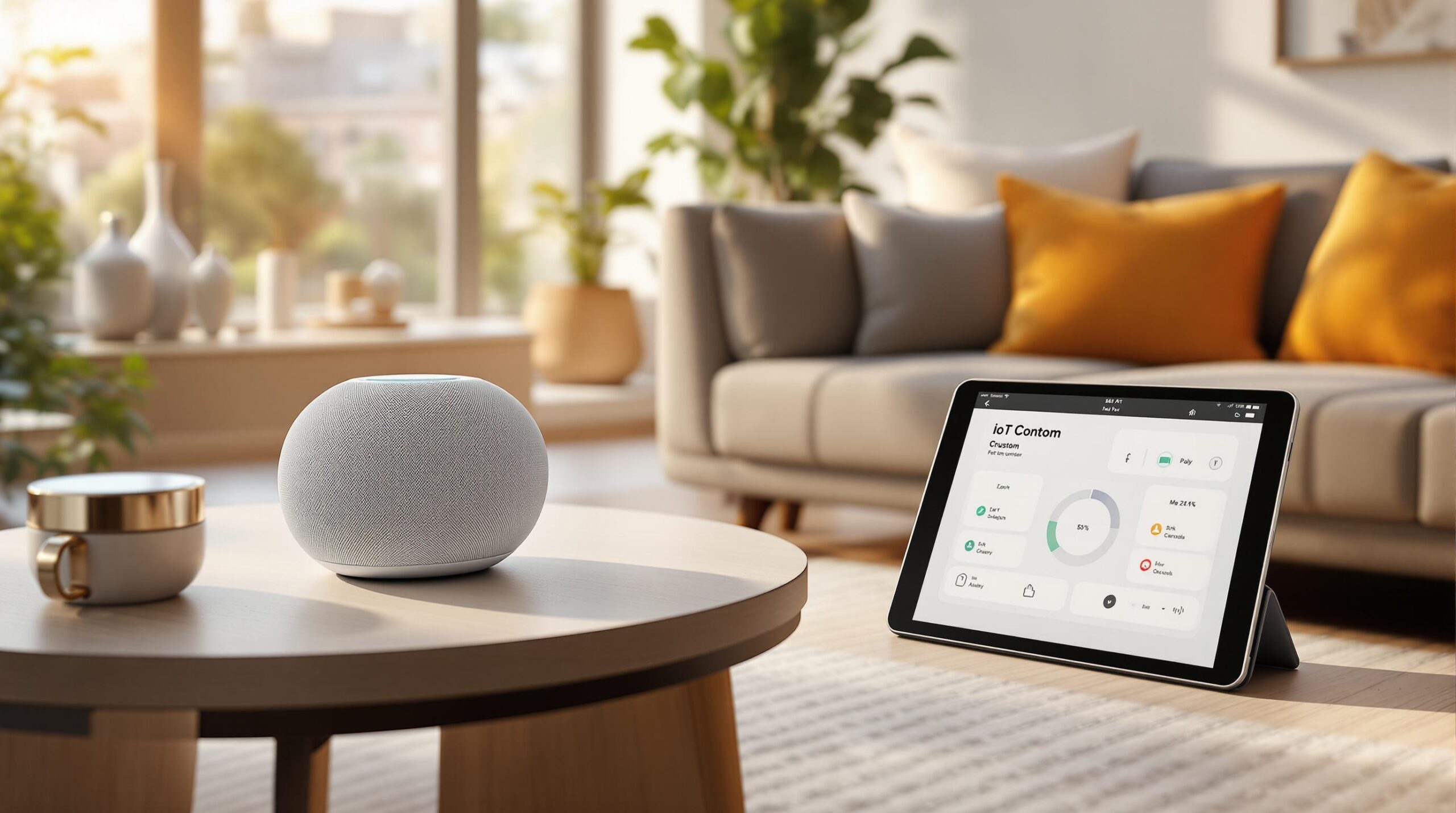
When deciding how users will control IoT devices, brands face two main options: voice assistants or custom apps. Each has its strengths and weaknesses, and the choice depends on your business goals, user needs, and technical requirements.
- Voice Assistants: Quick, hands-free, and great for simple tasks. They rely on platforms like Alexa or Google Assistant but come with privacy concerns and limited control over user data.
- Custom Apps: Offer precise control, visual feedback, and full ownership of data. However, they require more time and resources to develop and maintain.
Quick Comparison
| Feature | Voice Assistants | Custom Apps |
|---|---|---|
| Interface Type | Voice-only | Combines voice + visuals |
| Control Options | Basic commands | Detailed, specific control |
| Data Ownership | Limited by platform | Full control |
| Privacy | Platform-dependent | Customizable security |
| Development | Ready-to-use platforms | Requires significant resources |
Key Takeaway: Voice assistants are ideal for quick, hands-free tasks, while custom apps excel in complex, secure, and branded IoT interactions. Many brands combine both to leverage their strengths.
Voice Assistants and Custom Apps: Core Concepts
Voice Assistant Basics
Voice assistants rely on natural language processing to understand spoken commands and manage IoT devices hands-free through cloud-based systems. These tools have made a noticeable impact across different industries.
Take Mercedes-Benz’s MBUX system, for example. It excels in understanding natural language, letting drivers adjust settings through simple conversation. As MotorTrend explains:
"MBUX’s sassy personal assistant function is a lesson in how to do voice commands properly. Taking learnings from mobile devices like smartphones and tablets, MBUX doesn’t require you to say a specific phrase to get it to do what you want. Need the climate controls dialed down? Just say, ‘Hey Mercedes, I’m cold’ and the system will immediately adjust the temperature."
In the financial world, Bank of America’s voice assistant Erica handled over 50 million client requests between June 2018 and May 2019. While voice assistants shine in simplifying tasks, custom mobile apps offer a more tailored and interactive experience for IoT ecosystems.
Custom App Fundamentals
Custom mobile apps are designed to provide specific interfaces for IoT systems, combining visual feedback with precise controls for a better user experience.
Their strength lies in their focused functionality. For instance, Pandora’s Voice Mode allows users to control music effortlessly while also offering visual feedback. Similarly, Nike’s Adapt Huarache sneakers let users adjust their laces via voice commands, showcasing practical IoT integration.
Some key benefits of custom apps include:
- Data Ownership: Businesses retain full control over user interaction data, enabling constant improvements.
- Domain Specificity: Apps are tailored to meet specific user needs.
- Brand Integration: The interface can reflect a company’s values and identity.
The automotive industry demonstrates the effectiveness of combining these technologies. Hyundai’s Venue SUV integrates voice commands with visual dashboard feedback, creating a smooth blend of audio and visual controls.
| Feature | Voice Assistant Integration | Custom App Implementation |
|---|---|---|
| Interface Type | Audio-focused | Multi-modal |
| Control Options | Basic commands | Detailed control |
| Data Control | Platform-dependent | Full ownership |
| User Focus | General purpose | Domain-specific |
These tools cater to different IoT applications, and the choice between them depends on the specific needs of the business and its users.
Key Differences Between Voice Assistants and Custom Apps
Voice Assistant Capabilities and Limits
Voice assistants use natural language processing to offer hands-free control of IoT devices. While their ease of use has driven widespread adoption, they come with notable concerns about privacy and data management. James Poulter, CEO of Vixen Labs, highlights these issues:
"We are seeing many brands and businesses expanding beyond the boundaries of Alexa and Google to build their own custom assistants – this raises new concerns when it comes to privacy and trust. Whilst consumers aren’t always trusting of the big platforms – we at least have some insight into how they are handling data and the measures in place to protect us."
Edge voice assistants provide an alternative by keeping data stored locally, which is especially useful in industries where sensitive information is involved. While voice assistants shine in terms of speed and convenience, their limitations pave the way for exploring the unique benefits and challenges of custom apps.
Custom App Features and Constraints
Custom apps, unlike voice assistants, require more time and resources to develop and maintain. However, they offer advanced features, such as combining voice commands with visual feedback, enabling more complex interactions for IoT systems.
Roy Lindermann, CMO of Readspeaker, points out the flexibility that custom solutions provide:
"Another key aspect is that brands do not want to be tied in with Big Tech vendors. They want the freedom to choose the best of all worlds and to be able to work with innovative players, who are customer-focused, act in the brand’s best interest, and with whom they do not have any conflict of interest and provide flexible commercial solutions."
Custom apps are tailored to meet specific needs, addressing the discoverability issues that general-purpose voice assistants often face.
Side-by-Side Comparison
Here’s a quick breakdown of how voice assistants and custom apps differ when it comes to IoT integration:
| Feature | Voice Assistants | Custom Apps |
|---|---|---|
| Development | Ready-to-use platforms | Requires significant resources |
| Data Control | Limited by platform | Full control over data |
| User Interface | Voice-only | Combines voice and visuals |
| Privacy | Dependent on platform | Customizable security options |
| Integration | Platform-restricted | Flexible and adaptable |
Bradley Metrock, CEO of Project Voice, raises a critical point about the risks tied to data privacy:
"A major concern for the foreseeable future will be how voice data can be combined with other types of data to produce unintended consequences. We have very little insight into what behaviors and actions are predicted when we combine the sound of our voice, the words we speak, the situation we’re in, and other socioeconomic factors."
sbb-itb-7af2948
Choosing Between Voice Assistants and Custom Apps
Best Uses for Voice Assistants
Voice assistants are perfect for quick, hands-free tasks, such as:
- Controlling smart home devices while multitasking
- Accessing information while driving or cooking
- Handling simple, everyday commands
They’re also fast – up to 3.7 times quicker than typing. This makes them a great fit for IoT applications that require instant responses.
When to Build Custom Apps
Custom apps shine when productivity and specific business needs take center stage. They work best in situations like:
- High Data Security Needs: Offering better control over sensitive IoT data
- Complex Interactions: Combining voice commands with visual feedback for a richer user experience
- Specialized Use Cases: Delivering tailored solutions to meet precise needs, avoiding the limitations of general-purpose voice assistants
Costs can vary widely, from $10,000 for basic integrations to over $100,000 for enterprise-grade solutions. While custom apps provide more control and security, combining them with voice assistants can harness the strengths of both.
Using Both Solutions Together
Many IoT setups combine voice assistants and custom apps to create well-rounded systems. In this approach, custom apps manage detailed operations and visual elements, while voice assistants handle routine tasks. A custom backend ensures secure data handling and smooth voice query management.
Some strategies for blending these technologies include:
- Using cloud-connected voice features with built-in technology backups
- Ensuring smooth transitions between the two interfaces and refining them based on feedback
Private vs. Cloud Voice Assistants (Home Assistant Voice …
Making Your Final Decision
When selecting the best interface for your IoT brand, keep these key factors in mind:
-
User Interaction Patterns
Voice interfaces are ideal for hands-free scenarios, such as cooking, driving, or other physical activities. With 40% of adults using mobile voice search daily, it’s clear that voice technology continues to gain traction. -
Technical Requirements
Building a custom voice assistant involves several components: wake word detection, automatic speech recognition, natural language understanding, decision-making capabilities, and text-to-speech processing. -
Business Impact
A 2022 survey highlighted key priorities for businesses, including boosting productivity, uncovering new opportunities, and driving revenue growth. -
Integration with Existing Systems
Your chosen solution should work seamlessly with current systems. Custom voice assistants, for example, can enhance your offerings by embedding voice functionality into existing customer experiences. -
Multi-modal Interfaces
For applications that need both voice and visual elements, consider a multi-modal interface. This setup allows users to make voice requests and receive responses with accompanying visuals. -
Development Strategy
Custom solutions benefit from open APIs, analytics tools, and iterative development. These elements help ensure smooth third-party integration and better responsiveness.
There’s no one-size-fits-all answer here. Many successful IoT implementations combine voice technology with custom apps, using voice for quick commands and apps for more complex tasks. As Jason Fields from Voicify News puts it:
"Unlike previous efforts in voice, organizations can deliver real value with custom voice assistants because ownership of the end-to-end experience offers total control and freedom".

